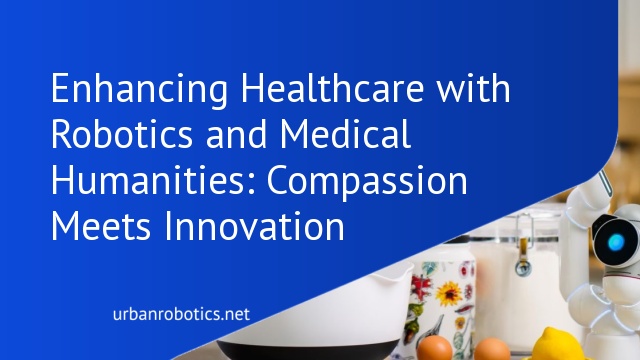Understanding Medical Humanities
Medical humanities integrate disciplines like ethics, history, and the arts into healthcare. These disciplines emphasize the importance of empathy, compassion, and ethical practice. By studying medical humanities, healthcare professionals can gain a deeper understanding of the human experience of illness and treatment.
Ethics provide a framework for making decisions that respect patient autonomy and dignity. History offers lessons from past medical practices, helping us avoid previous mistakes. Arts help in understanding patient stories and fostering a deeper connection with them.
Integrating medical humanities with robotics means ensuring that advanced technology serves the patient’s best interests. Robots can manage routine tasks, freeing healthcare professionals to focus on the human aspects of care. This balance enhances the quality of interactions between patients and caregivers, promoting better health outcomes.
The Intersection of Medical Humanities and Robotics
Integrating medical humanities with robotics in healthcare enhances patient experiences and ensures balanced care that combines innovation with human touch. This intersection brings value to both patients and healthcare providers.
Integrating Arts and Sciences
Blending arts and sciences enriches healthcare by fostering holistic patient care. Arts, like visual arts and literature, help in understanding patient emotions and improving communication. Sciences, including robotics, enhance precision in diagnostics and treatment. Combining these fields results in more empathetic and effective healthcare solutions.
Ethical Considerations
Addressing ethical considerations in robotics is essential for trust in healthcare systems. With the implementation of robots, it’s crucial to consider patient privacy, data security, and informed consent. Establishing ethical guidelines ensures that technological advancements respect patient dignity and autonomy. Integrating ethics aids in creating a responsible framework for robotic applications in healthcare.
Applications of Robotics in Healthcare
Robotics plays a crucial role in modern healthcare settings, enhancing both patient care and clinical operations. Here’s how robotics integrates into healthcare systems.
Clinical Settings
Robots assist in various clinical operations, improving efficiency and precision. Surgical robots perform minimally invasive procedures with enhanced accuracy. Examples include the da Vinci Surgical System, which offers precise control in complex surgeries. Robots also aid in diagnostics by conducting repetitive tasks like drawing blood and analyzing samples, reducing human error. Facilities use autonomous robots for disinfection, ensuring sterile environments critical in preventing hospital-acquired infections.
Patient Care and Support
In patient care, robots offer significant support by augmenting human efforts. Companion robots provide emotional support to patients, particularly the elderly and those with chronic conditions, enhancing mental well-being. Examples include the Paro robot, which interacts with dementia patients to improve their emotional state. Additionally, robotic exoskeletons aid in rehabilitation by helping patients regain mobility after injuries or surgeries. These devices support physical therapy, offering precise and consistent assistance tailored to individual recovery plans.
Case Studies and Real-World Examples
Let’s explore practical instances highlighting the fusion of medical humanities and robotics in healthcare. These cases underscore both triumphs and obstacles encountered in integrating these fields.
Success Stories
Several hospitals have integrated robotic systems to enhance patient care. The Cleveland Clinic, for example, uses robotic-assisted surgeries, blending precise robotics with compassionate care provided by trained surgeons. Similarly, Boston Children’s Hospital employs robots like Moxi to deliver supplies and medication, freeing up healthcare professionals to focus on direct patient interactions. These integrations lead to efficient operations and more empathetic care.
Challenges Faced
Despite numerous successes, challenges persist. One significant issue involves the high costs of deploying and maintaining robotic systems, which can strain hospital budgets. Another challenge is ensuring that robotic systems align with the ethical standards integral to medical humanities. Training healthcare staff to effectively incorporate these technologies poses another difficulty, impacting the seamless integration of empathy-driven care with advanced robotics.
Future Prospects and Innovations
The synergy of medical humanities and robotics shows promise for future healthcare advancements. In the coming years, we expect greater implementation of AI-driven robots capable of empathetic interactions. These robots would not only assist in surgeries but also engage patients emotionally, helping reduce anxiety and improve overall care experiences.
Augmented reality (AR) and virtual reality (VR) technologies will likely integrate into rehabilitation programs. Using AR and VR, we can create immersive therapeutic environments, accelerating patient recovery. For instance, VR-based treatments could support mental health care by providing patients with controlled exposure therapy in a secure setting.
Personalized medicine, powered by robotics and AI, stands to revolutionize treatment plans. Robotic systems can deliver tailored therapies based on individual genetic profiles, enhancing the precision of medical interventions. Hospitals already experimenting with personalized approaches have shown improved patient outcomes, setting a precedent for future practices.
Lastly, ongoing research in biomimicry aims to create robots inspired by human anatomy. These bio-robots can mimic human movements and functions, offering more natural and responsive assistance to patients.
Conclusion
Merging medical humanities with robotics in healthcare offers a transformative approach that balances technology with human touch. By integrating empathy and ethical considerations into robotic systems, we can enhance patient care in ways previously unimaginable. Institutions like the Cleveland Clinic and Boston Children’s Hospital are already demonstrating the potential of this integration.
Looking forward, advancements in AI-driven robots, AR and VR technologies, and personalized medicine promise even greater improvements. However, we must address challenges such as high costs and ethical alignment. With ongoing innovation and collaboration, we can create a healthcare system that truly combines the best of both worlds.





